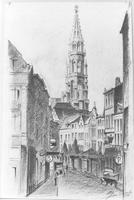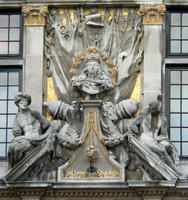You are in: Europe -> Belgium -> La Grand-Place, Brussels, and traditional search or Image Gallery will yield results of this site only
La Grand-Place, Brussels
| Site number: | 857 |
|
| Type of site: | Cultural | |
| Date: | late 17th c. | |
| Date of Inscription: | 1998 | |
| Location: | Europe, Belgium, Brussels, Brussels-Capital Region | |
Up to 75 images are shown here. Click on each for more details or on Image Gallery for more images.
Six official UN languages:
Arabic,
Chinese,
English,
French,
Russian,
Spanish
Other languages: Danish, Dutch, Esperanto, Finnish, German, Italian, Japanese, Luxembourgish, Norwegian-bokmål, Portuguese, Swedish
Other languages: Danish, Dutch, Esperanto, Finnish, German, Italian, Japanese, Luxembourgish, Norwegian-bokmål, Portuguese, Swedish
| Description: | A remarkably homogeneous assembly of public and private buildings, La Grand-Place in Brussels mostly dates from the late 17th century. The architecture of this important political and commercial centre provides a vivid illustration to the contemporary viewer of the period’s level of social and cultural life. --WHMNet paraphrase from the description at WHC Site, where additional information is available. For 360 degree imaging of this site, click here. | |
| The Grand Place (French: Grand'Place or Grand Place, Dutch: Grote Markt) is the central market square of Brussels. It is surrounded by guild houses, the city's spectacular Town Hall and the Breadhouse (Dutch: Broodhuis, French: Maison du Roi). The square is the most important tourist destination and most memorable landmark in Brussels next to the Atomium. The town hall was constructed between 1402 and 1455. The original architect was probably Jacob van Thienen. The gothic tower was designed by architect Jan van Ruysbroeck. At the top of the tower stands a statue of St. Michael, the patron of Brussels. In the 13th century the predecessor of the Breadhouse was a wooden building where bakers sold their bread in a covered market: the Dutch name Broodhuis recalls this function. It was replaced in the 15th century by a stone building for the administration of the duke of Brabant; when the duchy fell to the Habsburgs, the Maison du duc (Duke's house) became the Maison du Roi (King's house). In 1873, the city entrusted architect Victor Jamaer to restore the battered structure in neo-gothic style. The Grand Place was first laid out after the construction of the town hall, at the centre of the city's commercial district. Neighboring streets still reflect the area's origins, named after the sellers of butter, cheese, herring, coal and so on. The original Grand Place was a medley of buildings constructed between the 15th and 17th centuries in a variety of styles. The square was rebuilt in the following four years by the city's guilds. Their efforts were regulated by the city councilors and the Governor of Brussels, who required that their plans be submitted to the authorities for their approval. This helped to deliver a remarkably harmonious layout for the rebuilt Grand Place, despite the ostensibly clashing combination of Gothic, Baroque and Louis XIV styles. The Grand Place was named by UNESCO as a World Heritage Site in 1998. One of the houses was owned by the brewers' guild, and is now the home of a brewers' museum. --Wikipedia. Text is available under the Creative Commons Attribution-ShareAlike License. For 360 degree imaging of this site, click here. | ||
| Source: | http://whc.unesco.org/en/list/857 | |
| Reference: | 1. UNESCO World Heritage Center, Site Page. | |












































































